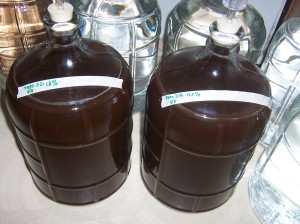Well I’m very happy to say, after an all-too-long break I’m back to making mead. I finally picked up a bucket of honey and wanted to immediately get some mead going (all of my carboys were empty!)
Right off, I wanted to get a batch or two of traditional mead going. I really enjoyed The Mad Trad Trial more than I expected to, and committed to making at least a couple of traditional meads per year. Now’s the time.
Of the 4 batches I did in the Mad Trad Trial, they were very close but Mad Trad D was my favorite so I reproduced that recipe. It used chaga & sumac tea as a base, with honey and Montrachet Yeast. I did 2 batches of 3 gallons each, for 6 gallons total.
I started with a strong, 3 gallon chaga decoction that simmered in fresh spring water for about 15 hours. For the last 15 minutes of the decoction, I added 3 sumac drupes. I used more chaga and sumac than I usually do because I wanted the tea to be stronger than usual, since I would be watering it down and splitting it between 2 batches.
Mad Trad D2a had an initial alcohol percentage of 18%.
Mad Trad D2b had an initial alcohol percentage of 17.5%.
I did not take pictures throughout the process (Look back at previous batches on this site if you need help visualizing it), but the final product looks great!

As always, I look forward to enjoying this mead toward the end of 2013.
UPDATE: 18 Aug 2013
Both of these cleared in the carboys, so I racked them today. Both are 13%ABV, which means Mad Trad D2a is slightly sweeter at 5% remaining potential, with D2B at 4.5%. Both of these are, once again, scrumptious with a fantastic honey flavor profile left behind.
Interestingly, the original Mad Trad D ended up slightly stronger at 14%, and slightly less sweet. This means the yeast crapped out a bit earlier on this batch than the previous one for some reason. It was later in the year, and we had quite a heat wave followed by a month of seasonally cool temperatures in the 70s, so that could be a related factor.
